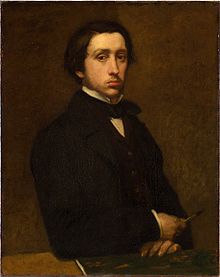Edgar Degas
![]()
Degas is a redirect to this article. For other meanings, see Degas (disambiguation).
![]()
This article is about the French painter and sculptor. For the variety of rose named after him, see Edgar Degas (rose).
Edgar Degas, civil name Hilaire Germain Edgar de Gas (b. 19 July 1834 in Paris; † 27 September 1917 ibid.), was a French painter and sculptor. He is often counted among the Impressionists, with whom he exhibited. His paintings, however, differ from those of the Impressionists in, among other things, their exact lines and clearly structured pictorial composition. On the one hand, Degas created numerous portraits; on the other, he concentrated on a few pictorial themes that he varied again and again: the ballet, jockeys and horses, Parisian nightlife, and women grooming themselves. He devoted himself to oil painting and graphic techniques as well as to pastel painting, in which he achieved extraordinary mastery. His sculptures show a new conception of sculpture.
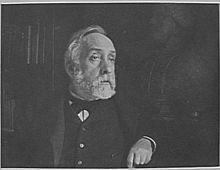
Self-portrait (1895), photograph
Life
Edgar Degas (to which he would later 'bourgeoisify' his name) was born in Paris on 19 July 1834, the first of five children of Auguste de Gas (c.1795-1874) and his wife Célestine Musson (1815-1847). The father, a native of Naples, managed the Paris branch of the family bank in Naples. The mother was of Creole descent and came from New Orleans; she died when the son was 13. Degas grew up in an upper-middle-class environment open to the arts. After attending the Collège Louis-Le-Grand, he began to study law at his father's request, but he soon gave it up to pursue a career as an artist. His father supported him, among other things, by providing him with a suitable studio. From 1853 Degas took lessons with the Ingres pupil Louis Lamothe. In 1855 he attended the École des Beaux-Arts for a short time. Afterwards, he preferred to continue his artistic education on his own. In the Paris museums he drew from antique reliefs as well as from the models of old masters.
In 1856 Degas set off on the study trip to Italy that was customary for visual artists at the time. He first visited his relatives in Naples and then spent about a year and a half in Rome, where he was busy drawing. In July 1858 he continued his journey to Florence, where he again stayed with relatives, the Bellelli family. He made numerous studies of the relatives, which were to serve as the basis for a planned group portrait.
Degas returned to Paris in April 1859. He now considered his studies to be completed and himself capable of mastering more demanding projects. He demonstrated his ability with the large-format group portrait The Bellelli Family. Although the young artist saw himself primarily as a portraitist, he nevertheless considered it essential to prove himself in the field of history painting, which ranked first in the hierarchy of pictorial genres at the time. By 1865 he had produced five history paintings; one of them, Medieval Battle Scene, he exhibited at the Salon in 1865, where it met with little response from the public or the critics. This, together with the doubts he had already had about the value of history painting, prompted him to concentrate henceforth entirely on subjects of contemporary Parisian life. He was helped in this by his more experienced colleague Édouard Manet, whom he had met years earlier while copying together in the Louvre. He also came into contact with other modern artists and writers such as Paul Cézanne, Pierre-Auguste Renoir and Émile Zola. Of particular importance for his further artistic development was his acquaintance with the writer and art critic Edmond Duranty. From 1866 to 1870 he continued to exhibit annually at the Salon.
During the Franco-Prussian War of 1870/71 Degas served as an artilleryman in Paris; it is from this time that the first complaints about his eye complaint have survived. He spent the weeks of the bloody Paris Commune with friends in the country.
In 1872/73 the painter traveled to New Orleans, where his numerous relatives on his mother's side lived. Two brothers had also settled there in the meantime; members of the family were active in the cotton business. During the five-month stay, he produced a series of portraits of the relatives, including the painting The Cotton Office in New Orleans. The next year, the father died. It subsequently became apparent that the Paris bank had been kept afloat only by loans and, moreover, that Degas's brother René had accumulated large business debts. The bank was liquidated two years later, and Degas felt obliged to pay for his brother's debts. He had to sell parts of his art collection and cut back on his lifestyle to do so. However, his financial situation improved significantly again in later years, as his works saw immense price increases. This was also due to the promotion by his art dealer Paul Durand-Ruel.
In 1874 Degas, together with a group of progressive artists, organized the first of a series of exhibitions that would later become known as the 'Impressionist Exhibitions'. They were launched with the intention of breaking the exhibition monopoly of the established 'Salon'. Degas took part in all but one of the eight exhibitions held up to 1886. In doing so, he rendered outstanding services to the preparation and organization, but on the other hand caused many tensions and disputes with his uncompromising attitude and his lack of understanding for the concerns of the other participants.
In the 1890s Degas developed into an enthusiastic photographer; he preferred to take portraits of people from his environment. He exhibited the results in 1895.
Degas remained unmarried. Nothing is known about his relationships with women, which gave rise to many rumors among his contemporaries. In his later years, his often brusque and spiteful manner, combined with his own sensitivity, caused acquaintances to turn away from him. Degas was a fierce anti-Semite. In the Dreyfus Affair, which polarized the nation beginning in 1894, he took sides against the accused Jewish officer, which cost him many friendships, including that with fellow painter Camille Pissarro. Also, the events surrounding the affair caused him to break with particularly close friends, a family of Jewish descent. He made new friends with fellow painters and their families such as Georges Jeanniot and Louis Braquaval. He met Braquaval around 1896 in Saint-Valery-sur-Somme, where Degas also painted some late landscapes in oil.
The painter's eyesight diminished more and more over the years. Therefore, he was finally forced to stop oil painting. Around 1908, Degas produced his last pastels and drawings, but continued to work on sculptures for some time. He spent the last years of his life, lonely and almost blind, in the care of a niece. Edgar Degas died of a cerebral hemorrhage on September 27, 1917.
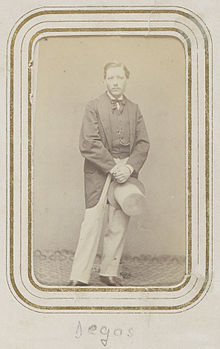
Edgar Degas
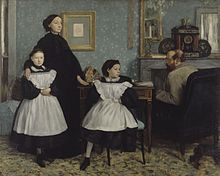
The Bellelli Family (1858-1867), oil on canvas, 200 × 250 cm
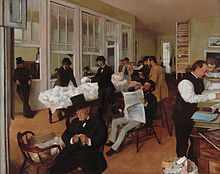
The Cotton Office in New Orleans (1873), oil on canvas, 73 × 92 cm
Works
Painting
Topics
One genre of painting that accompanied Degas throughout his life was the portrait. He rarely accepted portrait commissions, preferring instead to use family members or people from his circle of acquaintances as models; he usually kept the paintings in his possession. Thus he was free from external demands. Degas's portraits are characterized by a high level of psychological observation and representation. His depictions of families and couples often show "discreet ruptures in which estrangement announces itself". With few exceptions, the sitters are not depicted against a neutral background, but in an environment appropriate to them.
In the 1860s, Degas created five large-scale history paintings; history painting was considered the pictorial genre with which an artist could earn the highest recognition. All five paintings are about women: The Daughter of Jephthah (1861-1864), Semiramis Contemplating the Babylon She Built (1860-1862), Medieval War Scene, (1861-1865), Young Spartan Women Challenge Young Boys (c. 1860-1862) and Mademoiselle Eugénie Fiocre in the Ballet 'The Spring' (1866-1868). But the painter realized that history painting did not suit his real aims; the figures in these paintings, with their individual facial features, already seem contemporary. Finally, Degas abandoned the historical subject and concentrated entirely on themes of the present.
· 
The Art Collector (1866), oil on canvas, 53 × 40 cm
· 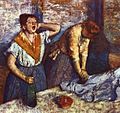
The Ironwomen (c. 1882), oil on canvas, 78 × 81.5 cm
· 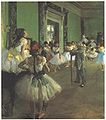
The Dancing Lesson (c. 1874), oil on canvas, 85 × 75 cm
· 
The Toilet (c. 1885), pastel on paper, 74 × 60.6 cm
From now on, his models were the people, especially the women, of modern, metropolitan Paris. On the one hand, these were the members of his own bourgeois social class and the places where they spent their leisure time: the racecourse, the museum, the theatre and the concert. On the other hand, he preferred to depict women from the opposite end of the social ladder: Laundresses and ironers, cleaners, prostitutes. This interest in social reality prompts the art historian Werner Hofmann to classify Degas's work as Realism. One of Degas' major themes, and one that was also preferred by collectors, became the dancer. Of the well over 200 works on the subject of ballet, only a little more than a fifth deal with the actual performance; the rest show the dancers, almost always nameless in Degas' work, behind the scenes, at rehearsal or resting. The ballet as a main motif, with an almost exclusive interest in the depiction of the individual dance(s) themselves, in the individual ballet works and in the concrete prominent dance artists, is only found later in the work of Ernst Oppler, who was around 30 years younger.
Central to Degas's late work is a series of paintings, mainly pastels, of female nudes bathing, washing, drying themselves, combing their hair or having their hair done. The painter refrained from showing an ideal image of the female body, as had become the convention in academic painting. Instead, he depicted women in their natural forms and poses. As he himself put it, "Up to now the nude has always been rendered in poses that presuppose an audience, but these women of mine are respectable, plain human children who have no other interests than those inherent in their physical condition.... It's like looking through a keyhole."
Stylistic features
Degas' early portraits show the classicist style of his model Ingres, for example the portrait René Hilaire Degas from 1857. When the painter turned to the motifs of city life towards the end of the 1850s, his formal aims also changed. He now sought above all new, exciting spatial solutions. The attention he paid to the division of the picture surface and the precise delineation of forms distinguish him from the Impressionists, to whom he is often assigned.
· 
Place de la Concorde (c. 1875), oil on canvas, 79 × 118 cm (Ludovic-Napoléon Lepic and his two daughters)
· 
Musician at the Opera (1872), oil on canvas, 69 × 49 cm
· 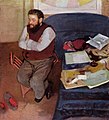
Diego Martelli (1879), oil on canvas, 110.4 × 99.8 cm
· 
Singer at a Café Concert (c. 1878), pastel on canvas, 51.4 × 40 cm
Characteristic of Degas' paintings are now decentralized compositions that move the actual action to the edge of the picture. This creates a tension between fullness on the one hand and empty space on the other, for example in the paintings The Dancing Class (c. 1871), Place de la Concorde (c. 1875) and Dancers at the Bar (1876/77). Figures are often cut up or cut down seemingly arbitrarily. This is done either by the edge of the picture, as in Place de la Concorde, where all four persons depicted, as well as the dog, can only be seen in fragments, or by objects placed in front of them, as in the painting Bei der Modistin (1882), where the standing mirror not only cuts up the space, but also fragments the body of the modiste. Both stylistic devices incorporate influences from the developing photography as well as Japanese prints, which were very popular among European painters at the time. They give the paintings the appearance of snapshots.
The influence of Japanese art is also reflected in Degas's tendency to flatten the pictorial space by dispensing with perspective. Sometimes floors, as in The Green Dancers (1877-1879), are projected less into the depths than into the surface, so that "[...] one thinks they are slipping into the bottomless pit, hardly giving the bodies any more support." The painter also achieved a planar effect by contracting the picture's foreground and background, skipping the middle ground. In the painting Musicians at the Opera (1872), the distance between the musicians and the dancers on stage is eliminated. This also leads to extremely disparate proportions of the figures depicted.
Degas's delight in experimentation led him to seek unusual angles, as in Miss Lala in Circus Fernando (1879), seen steeply from below.
Pastel painting
At the beginning of the 1870s, Degas discovered pastel painting for himself and brought it to perfection in a creative process that lasted over three decades. His pastel paintings were admired by contemporary artists. He developed a special technique for his painterly pastels. The paintings were built up in numerous layers, with each newly added layer of paint being fixed. For this purpose, Degas used a special fixative whose recipe he had brought with him from Rome. With his method he achieved a luminous colorfulness and a dry color effect reminiscent of fresco paintings. Degas' pastels became the model for many subsequent artists.
How it works
Degas rejected the open-air painting that the Impressionists liked to practice. He worked in the studio with the help of models or from drawings he had made on site or even taken from a pre-existing fund. "There has never been a less spontaneous art than mine," he explained. "What I do is the result of reflection and study of the great masters. Of inspiration, spontaneity, temperament [...] I know nothing." In 1895/96 Degas became involved with photography; there is evidence of two paintings from this period for which he used his own photographs in preparation. However, as the process apparently did not satisfy him, he subsequently returned to drawing. Degas attached great importance to drawing and painting from memory because of the associated release of the imagination.
What has been handed down is the artist's habit of reworking finished pictures over and over again.
Drawing
Degas drew throughout his fifty-year creative period, until he had to abandon this artistic discipline around 1908 because of his poor eyesight. There are numerous surviving statements that make clear the importance he attached to drawing and that he valued his drawings more highly than his painting.
The artist's love of experimentation is evident in his choice of means of representation. He drew with pencil, chalk, charcoal, pastel pencils and diluted oil paint on paper, some of which was tinted in color, often combining different techniques on one and the same sheet. Degas had a particular predilection for colored drawings; for this, pastel chalk became his preferred medium from the early 1870s. It allowed him to combine a linear, graphic mode of representation with painterly flatness. Many of his pastels are so strongly pictorial that the distinction between them and painting becomes blurred.
·
Studies after an antique head, leg and foot studies (1854-1855), pencil, 32 × 20 cm
· 
Giulia Bellelli (Study for The Bellelli Family) (1859-1860), diluted oil paint on cardboard, 36 × 25 cm
· 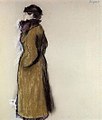
Ellen Andrée (c. 1879), pastel on grey-green paper, 48.5 × 42 cm
·
Two washerwomen and horses (c. 1902), charcoal and pastel on paper, 84 × 107 cm
During his years of study from 1853 to the end of the 1850s, Degas used the medium of drawing primarily to acquire the knowledge and methods of older models. He made more than 740 drawings, mostly after Renaissance and Classicist masters. He concentrated on figurative representations. His drawing style in this phase shows a growing certainty and spontaneity.
After that, Degas used drawing on the one hand to prepare paintings, on the other hand he increasingly produced drawings that were intended as a 'final purpose'. From the 1880s onwards, his drawings surpassed his paintings. The late work is characterized by larger formats (due to the declining eyesight) as well as a progressive coarsening and the abandonment of spatial illusion.
Printmaking
Degas's love of experimentation and interest in new techniques are particularly evident in the field of printmaking. He created numerous etchings, using both drypoint and etching techniques, as well as aquatint, and mixed these processes together. He also experimented with lithography. He became famous for his monotypes. By means of this printing technique, only one clear and at most one or two weaker prints can be produced, which Degas often reworked with pastel chalk. The mostly small-format monotypes show scenes from the ballet, theater, and everyday life in a brothel.
Sculptures
After Degas' death, more than 150 sculptures were found in his studio, most of them in a poor state of preservation. Only one of these, the Fourteen-Year-Old Dancer, completed in 1878, was exhibited publicly in 1881. The others, depicting horses, dancers and bathers, are dated to Degas's later years. Presumably, after failing eyesight made painting impossible, he concentrated entirely on three-dimensional works. The earlier view that they served as models for paintings is no longer shared by most experts. Degas used different materials for the sculptures, such as wax, clay, plasticine and textiles. This and the resulting polychromy were alien to traditional sculpture.
The Fourteen-Year-Old Dancer was exhibited by Degas at the Sixth Impressionist Exhibition in 1881. Dressed in a real skirt and dancing shoes made of fabric, a linen bodice, a hair ribbon of satin and horsehair, the wax figure with realistic facial features stood outside the established sculptural art of the 19th century. She was judged differently by critics. While some condemned its "horrible reality", finding it "ugly" or "puny", others, such as the writer Joris-Karl Huysmans, saw in it a forward-looking conception of sculpture: "[...] all the public's ideas about sculpture, about these cold, lifeless, white apparitions, about these memorable stencilled works that have been repeated for centuries, are overthrown. The fact is that Monsieur Degas has overturned the traditions of sculpture [...]."
Posthumously, Degas' heirs had bronze casts made of 72 of the sculptures, some of them in quite large editions.

Fourteen-year-old dancer , bronze casting from 1922 after the original sculpture from 1878, bronze, partly painted, with tulle skirt and satin ribbon, height with base 105 cm
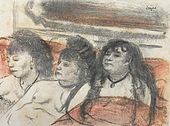
Three Prostitutes on a Sofa (c. 1879), pastel over monotype, 16 × 21.5 cm
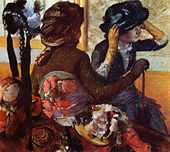
At the Modiste (1882), pastel, 75.5 × 85.5 cm
Questions and Answers
Q: Who was Edgar Degas?
A: Edgar Degas was a French artist.
Q: What is Edgar Degas famous for?
A: Edgar Degas is famous for his paintings, sculptures and being one of the founders of the Impressionist movement.
Q: What subject is Edgar Degas identified with?
A: Edgar Degas is identified with the subject of the dance.
Q: How many of Edgar Degas' works depict dancers?
A: Over half of Edgar Degas' works depict dancers.
Q: What is notable about Edgar Degas' portraits?
A: Edgar Degas' portraits are notable for their psychological complexity and the way they show human isolation.
Q: Did Edgar Degas accept being called an Impressionist?
A: Edgar Degas rejected the term Impressionist and preferred to be called a realist.
Q: What is Edgar Degas' forte?
A: Edgar Degas' forte is his mastery in the depiction of movement.
Search within the encyclopedia
